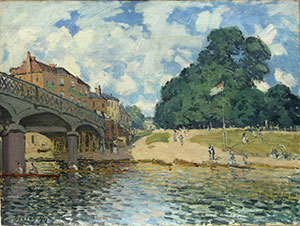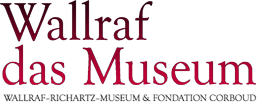Brief Report
This cast-iron and brick bridge was built in 1865 to link Hampton Court Palace with the town of East Molesey on the opposite bank of the Thames. The third bridge on the site, it was itself replaced by the present structure in 1933. During Sisley's four-month stay in Hampton in the south-west suburbs of London in 1874, he painted two more views of the bridge, which was at that time only nine years old, and its immediate surroundings [Daulte 1959, cat.nos. 124 and 125]. From the standpoint of the artist on the low bank, we look towards a group of buildings on the street leading to the bridge on the far side of the river. The right-hand half of the picture is taken up by the green bank with numerous people strolling beneath large trees on a summer's day with well-broken cloud in a blue sky. A bridge diagonally running from the left into the distance is a motif we find frequently in Sisley's work: he employed it for the first time in 1872 in his depiction of the bridge at Villeneuve-la-Garenne [Daulte 1959, cat. no. 37]. Evidently Sisley acquired the commercially pre-primed canvas locally, in landscape size (24.0 x 18.0 inches), it was obtained from the London firm of Winsor & Newton, whose company stamp can be seen on the canvas verso [cf. Winsor & Newton 1863, p. 117] (figs 2, 14). The artist presumably sketched the composition in charcoal on the pale, warm-grey ground before laying in the major zones of the picture in very thin paint (fig. 11). On this foundation, he gradually differentiated the motifs with lively brush-strokes. Alongside the brush he also occasionally used a scratching instrument (presumably the brush shaft) to add precision to the contours in the still fresh paint (fig. 9). In the sky region, the pale grey ground often plays a part in the effect. However, closer inspection reveals that what we have here is not simply unpainted canvas, but places where drying paint was evidently in many places scraped off or removed with a cloth (fig.12). It is uncertain whether Sisley deliberately made use of this effect, or whether he was simply removing foreign bodies that had got into the wet paint. He signed the work while applying the final brush-strokes, so that the inscription is in places blended wet-in-wet with the underlying paint applications (fig. 6).
Alfred Sisley
born on 30 October 1839 in Paris,
died on 29 January 1899 in Moret-sur-Loing
Further illustrations:
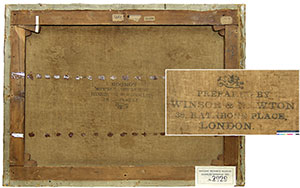
Fig. 02
Verso, with detail of the Winsor & Newton company stamp (turned through 180°), on the painting verso can be seen traces of fastening and remains of a fastening system dating from the 1860s/70s: two tinfoil strips stuck on with a wax mixture
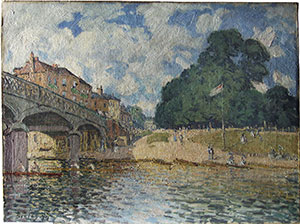
Fig. 03
Raking light
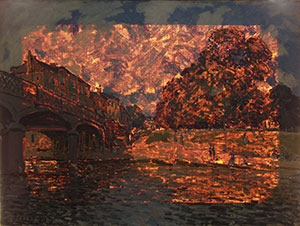
Fig. 04
Transmitted light
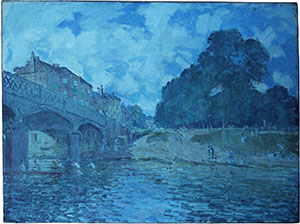
Fig. 05
UV fluorescence
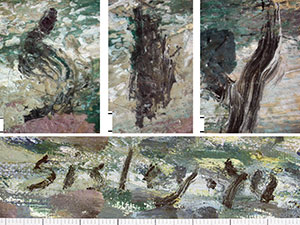
Fig. 06
Details of the signature, which was applied wet-in-wet, at the same time as a few final colour accents which overlap it, microscopic photograph (M = 1 mm)
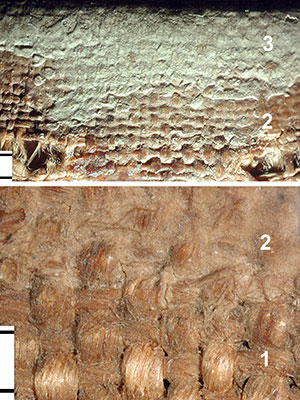
Fig. 07
Details of the turnover-edge of the canvas with the edge of the size application (1) and the two-layer ground (2 and 3), microscopic photograph (M = 1 mm)
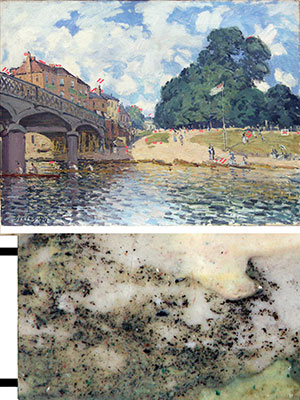
Fig. 08
Mapping of the places where underdrawing were noted, the charcoal particles being clearly visible under the stereomicroscope, microscopic photograph (M = 1 mm)

Fig. 09
Detail of the bridge in incident light (top), transmitted light (middle) and raking light (bottom): the outline of the arch was scratched into the wet paint
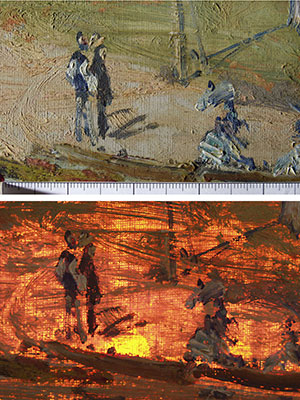
Fig. 10
Detail of the group of figures in raking light (top) and transmitted light (bottom)
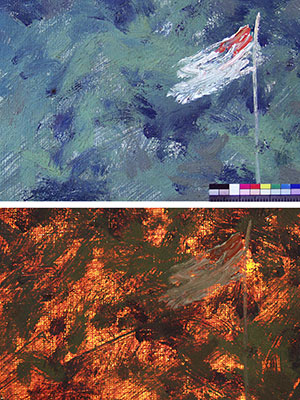
Fig. 11
Detail of the tree in incident light (top) and transmitted light (bottom); the first large-area lay-in with brisk green brush-strokes can be clearly seen beneath the subsequent paint applications

Fig. 12
Mapping and detail of the paint-layers subsequently manipulated or removed to reveal the ground in many places

Fig. 13
Detail of the inscription verso on the turnover edge and the stretcher in incident light (top) and in the IR reflectogram (bottom)
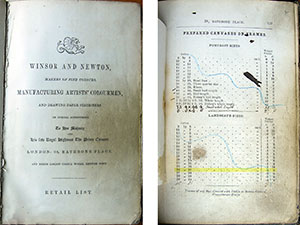
Fig. 14
Excerpt from the 1863 Winsor & Newton sales catalogue with the dimensions of their commercially prepared and primed canvases

